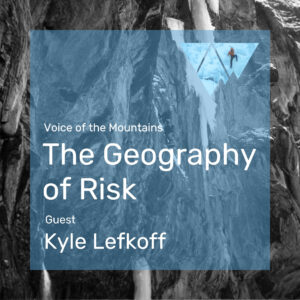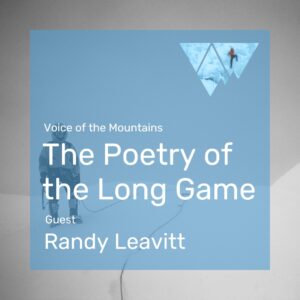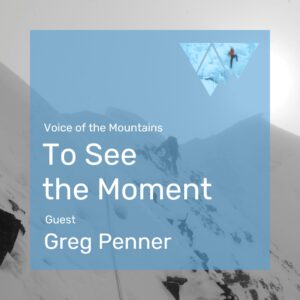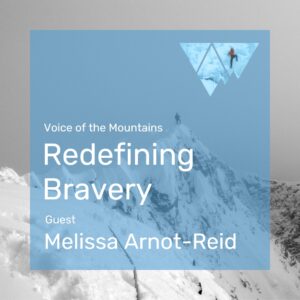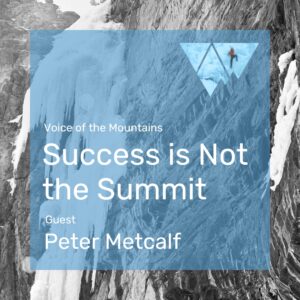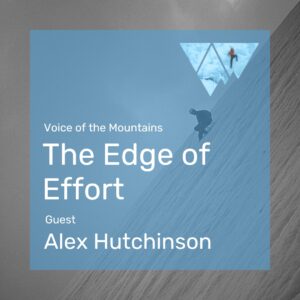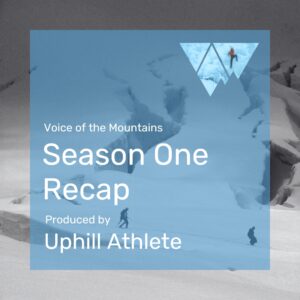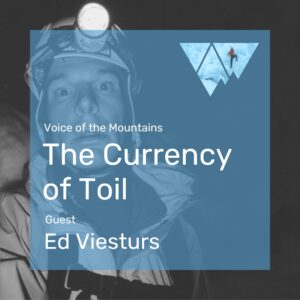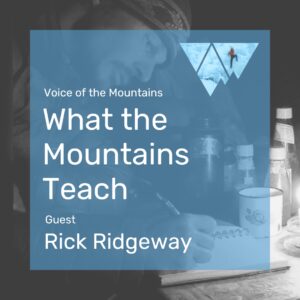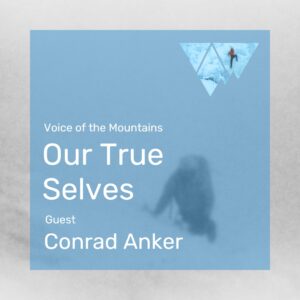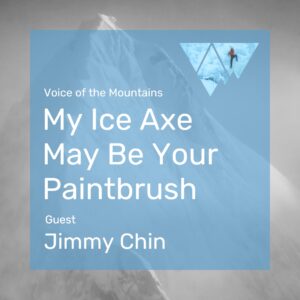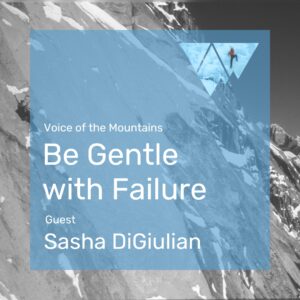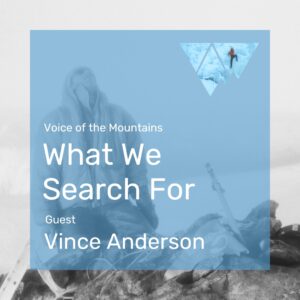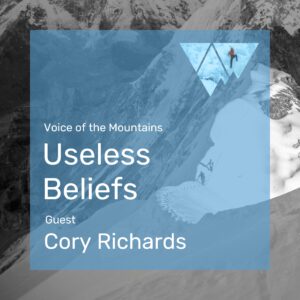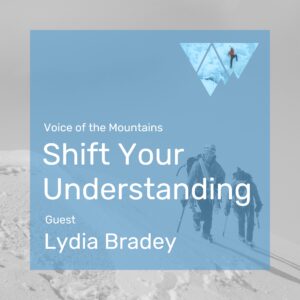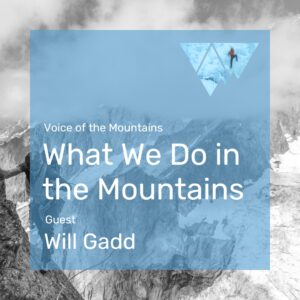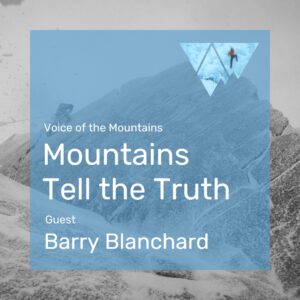To See the Moment
Guest Greg Penner
READ THE COMPANION ESSAY
Exploring the poetic soul of the mountains.
Voice of the Mountains explores the mental and emotional adventures found in discovering who we are and what we’re capable of. Here we engage in self-reflection, humility, and embrace the beauty and struggle of the alpine experience equally.
Listen to More
Steve: Something I tell my athletes is that you don’t rise to the occasion. You fall to the level of your preparation. It’s about reps. Reps done and the dark reps done. When you don’t feel like doing it. Reps when you’re just unsure if any of it matters and maybe you’re not that motivated. What happens if someone takes that same work ethic that we apply to training for mountain sports and applies it to the world of high stakes leadership?
Our guest today is Greg Penner, the chairman of the board of Walmart, one of the largest and most complex corporations in the world. He’s also the CEO of the Denver Broncos, and he’s an uphill athlete. Greg has raised triathlons. He’s climbed Mount Everest. He’s been turned back from the summit of Denali. And he’s someone I’ve shared Miles with on skis and snow and climbing ice.
Greg sits in a place that most of us, including myself, will never set. Rooms will. Most of us will never sit where Greg sits. But that’s exactly why I wanted to talk to him. When someone is able to navigate risk and pressure and performance at that level, and has shaped themselves in the world of endurance sport, we have to ask what they are carrying back from their training and racing and climbing that helps them in those situations?
What do they know that we can learn from? Greg is balancing culture, legacy and change on a global scale, and he’s doing it with the same mindset that we talk about as an uphill athlete every day. Staying consistent. Getting the right people on the rope. Learning from our mistakes and making every action count. In this episode of voice of the mountains, Greg and I are going to explore training, racing and climbing and how they have shaped Greg’s decision making processes.
I am going to ask him what it’s like to lead when the stakes are very, very, very high and why do the small choices that we make along the way, the reps done become so important? Whether you’re running a company or training for your next summit, or just trying to live with purpose in your own life, the mountains are always asking the same questions.
Have you done the reps? Have you done the preparation for. Let’s get started.
Steve: If you’re enjoying the show and want to take the next step in your training, join our newsletter and receive a free four week sample training plan. Head on over to uphillathlete.com/letsgo, and once you sign up, you’ll instantly get a link to try out some of our most popular training plans. It’s a great way to get a feel for how we train our athletes for big mountain goals. Check it out at uphillathlete.com/letsgo. That’s uphillathlete.com/letsgo.
Steve: Welcome to the podcast, Greg. It’s so great to see you and to have you here.
Greg: Thanks, Steve. Uh, great to be on and have a chance to visit with you.
Steve: Yeah, it’s been a minute since I last saw you. I believe the last time we saw each other was ski touring in Aspen. Ski up
Greg: Yep. I think it was, uh, Highlands up to the bowl.
Steve: up to the bowl. That’s right. It was a beautiful, clear, cold morning. I love that morning. It was really nice. And one, we were joined by a friend of yours and someone who I know just sort of more because he is a legend, uh, than anything. Um, you wanna introduce our mutual friend a little bit?
Greg: Yeah, that’d be, that’d be Neil Byman, uh, of, uh, he was actually on the 1996, uh, Everest climb and, and I got to know Neil, oh, probably 15 years ago now. Uh, just through a mutual friend, started skiing together, uh, biking together, and then eventually ended up doing a lot of climbing together. And, and, uh, we’ve had, we’ve had a lot of fun, a lot of, a lot of big adventures.
Steve: Neil is just a great guy and one of the absolute kinds of original legends of the mountain space, especially in Colorado. You know, he was running hard rock back before ultra running was even a thing. And of course, climbing and guiding on Everest at the dawn of that era, uh, has so many great stories. And he is a, he is a genuine rocket scientist, right? Like he’s.
Greg: He, he is, yeah. Yeah. No, he’s got a, uh, uh, booming, uh, business now and spending a lot of time in Boulder with that and, and, um, but still, still Ty, finding time to ski and, and bike and, and all that. So yeah, we still have a lot of fun in Aspen.
Steve: Just a great guy. So I want to segue to 2018, and along with, I believe Neil and some other friends, you were on Everest, you were climbing Mount Everest from the north side, from the Chinese side, and you and your, your whole team faced a critical moment up quite high when almost all of either oxygen regulators on your team, including yours, sort of spontaneously failed. And when I think about this, and when I heard about this originally, which was almost in real time, you know, turning back would’ve been a very logical choice. Anyone would’ve been like, yeah, okay. The regulators all failed. Of course they went down. That’s a perfect reason to, to turn around from high on Everest.
But you guys paused and regrouped and you found a different way forward. Can you briefly tell that story for our listeners?
Greg: Yeah. So, uh, not all of the regulators failed, but basically about half of the active regulators failed. And then we had gone through our backup. So, um, we were at about 28,200 feet. So we could see the summit. The sun was coming up. Um, everything had been going great up to that point. Um, so then we had to huddle and decide, do we, do we make a push for the summit?
At that point, knowing we had no backups, um. And, you know, it was, it was, and it’s hard is, you know, at that kind of elevation with ox, you know, oxygen masks on and everything to actually have a, a decent, you know, uh, uh, conversation. But, uh, but we made the decision to actually, um, uh, abort and go down. And so, um, and then once we decided to go down, we wanted to move down quickly given we didn’t have backup oxygen.
So, uh, we quickly made our way back down to camp two, kind of regrouped there, and then went all the way back to advanced base camp. Um, uh, and then had, you know, had, had made the decision then that we were done, you know, we had used, we had obviously staged oxygen and other supplies for the climb. We had used those on the, on the first summit attempt.
Um, and so we had made the decision, we were, we were not gonna try again. Um, I went to sleep thinking that was our decision. And when we woke up the next morning, we kind of sat around breakfast and. I think it was Jim maybe said, uh, is, are we sure there’s no way we, you know, we couldn’t do this again. Uh, give it another try.
And, and we just kind of started brainstorming and, uh, came up with some other, an Indian team had, had, had to, uh, abort their climb and they’d left a bunch of oxygen canisters up, up high and kind of regrouped and said, you know what, we’re fully acclimated. Let’s, see if we can, you know, in about 36 hours if the weather is still good, let’s, give it a hard push.
And, um, we climbed this. Then the next time in a, you know, we skipped the first camp, just spent half a night at the second camp and summited from there. So it was a, you know, it was a different protocol and ended up working out.
Steve: So, you know, you sit in some very interesting worlds and have some very interesting perspectives where you’re either the CEO or on boards of some of the world’s largest companies, and you’re out there doing these things like going skiing, touring and climbing Everest. When you think about that experience, are there experiences, are there other times in your business life or in your personal life, perhaps, where this experience you have in the mountains with risk and with working through problems and the way that you just described has, has come to play?
Has, and could you tell us a similar story and from that. Another part, another part of your life in that way.
Greg: Yeah, it’s interesting. Um, I mean, I’d say it’s actually, it actually goes both ways. So I would, you know, in processing a decision like that and, and thinking about it, it’s a lot of the same, um. Skills and, and learn practices that you have in business when you’re facing a big decision. When and usually those big decisions would be things around, you know, a big acquisition or a, a significant hire or firing that you’re needing to make, or how you approach a strategic partnership. Um, you know, where you have a lot of, you have a lot of options. Sometimes those are made in like, in, in situations like this where you have a very short, acute period of time to make a decision. Sometimes it’s, it’s longer duration, but I find a lot of the, a lot of the skills are the same, which is. You know, for me, making those types of decisions, whether it’s in business or on the mountain, it’s trying to, you know, you wanna elicit different voices and different opinions that span a range of maybe the most risk averse to the most, uh, risk tolerant in the case in the mountains.
And be able to assess, you know, how, how, you know, what are, what are the things we need to be thinking about, and is this a, is this a tolerable risk? Um, and just understanding that and whose voices you wanna listen to and how you process that. And then, you know, being decisive, uh, is I think a really valuable skill.
And it, it translates both in business and mountains.
Steve: I think one of the skills I would argue is the ability to recognize that you’re in that space to begin with. And is there something like an intuition or is it something you learn from being around other people doing it kind of growing up as either a mountaineer or growing up as a, as a business person that you, you pick up that sixth sense for knowing when you need to sort of stop and be like, okay, I need to, as you said, assess, like, what’s the, what’s the most risk tolerant?
What’s the least risk tolerant? What are the voices? What are the, what are the inputs? What is the decision that needs to be made? And then, you know. But that, but that first step of actually recognizing you’re in that place where you need to make a decision like that is sometimes less obvious than it is of the oxygen regulators, you know, blowing, you know, blowing up with a large, loud pop in the air.
Right. Like, um, is that, is that something that, that, that you found you have to really work on? Or how does that work?
Greg: Yeah. It’s interesting. I don’t, I don’t know that it’s something you necessarily, um, proactively work on, but I think the way you develop that sixth sense is through a lot of different experiences. And I’m always, I’ve been a big believer, I’ve always had a full-time work schedule. I basically have three different things that I spend time on now between our investment firm, Walmart and the Denver Broncos. Um. So that’s a, that’s always active. But then outside of that, I’ve always had an active, you know, pursuit, whether it be the mountains or racing in triathlons or, you know, whatever it might be. And I’ve just found diverse experiences where you’re really pushing yourself to achieve at a high level, whether it’s business, sports, the mountains, those things.
They’re complimentary. ’cause you, you, you learn and you see patterns and you, you know, all of them have, you know, different types of risk, but all of them have risks that you need to manage. Um, but you, I, you can’t be too risk averse or a lot of times you’re never going to achieve your objective.
And, and so I think that sixth sense just comes from that diverse set of experiences. Uh, not just in one place, but in, in multiple areas and fields.
Steve: Does that as, as you go through life, do you find yourself seeing patterns that you’re like, oh, I’ve seen this from that other perspective, from my perspective of being, you know, chair of my investment fund or CEO of Walmart or CEO of the Denver Broncos, and I’m seeing it from a different angle today, but I’ve seen this before.
But from there, does that, do you have those kinds of, sort of real time realizations.
Greg: Oh yeah. Yeah. I mean, a good, uh, I’m not sure if it’s applicable to the mountain, but a good one in, in business is, you know, when you have someone and their performance isn’t up to expectations and you think you can get them there. And you give that a little bit of [00:13:00] time and you keep letting it go, you think you can get them there?
The answer is like, at that point, you know, there’s some kind of fit, there’s some kind of, uh, fit that’s not right either. They’re not suited for it. It’s a role mismatch. Uh, there’s something else going on. Um, but that’s a, that’s, you know, with people and people are the most important decision you’re gonna make in any of these areas.
And, and, um, so that’s a, that’s a pattern that now I just know, okay, I’ve seen this before. This isn’t gonna work better to bite the bullet now move on, do it in the right way, you know, respectful and, and clear and, and decisive and, and, and move forward.
Steve: Well, I think this is actually a topic I wanted to get in with you, into with you, because I think there are a lot of. Overlap because, you know, people as you say are, are so critical to both business and to being in the mountains. Right? We just had a little side chat as we were warming up about like the different people we enjoy res we respectively enjoy being in the mountains with, and you know, you’ve met and climbed and skied with my good friend Vince Anderson.
And you know, we’ve met through mutual friends and there’s, you know, this famous Jim Collins quote, Jim Collins of course being the professor at the Standard for School of Business and the author of the famous book, Good To Great and also happens to be a really good rock climber. And one of the things that he always talks about and he talks about in Good to Great is to get the wrong people off the bus and the right people on the bus.
This sort of, this very sort of folksy sounding bit of wisdom that is so incredibly right in both the mountains and in terms of. Building businesses, and I see climbers and skiers struggle with this all the time, and they’ll put it in the lens of like, uh, yeah, I can’t find the right partner for this.
And, you know, I mean, it’s, it’s the same topic, right. How do you, uh, how do you think about that in the organizations that you’re, you’re leading as you, as you said, like you just said, people are the most important thing to get right. How do you, how do you learn to do that?
Greg: Uh, good question. I mean, I think it’s true. Uh, as many reps as you can in different environments and, and learning from your mistakes, uh, is how you, um, and you’re still never gonna get it right. So, and, and you’re right, it does apply to the mountains and you know, I’ve got lots of great friends that do, you know, many different activities with, but, but some I might not be willing to, you know, go up high and do a peak like Everest with just because, you know, it’s not the right personality fit or it’s a different perspective on risk or how they approach the mountains.
Um, same thing in business. Uh, they’re gonna be folks, they might be really smart, but their values don’t line up with you or, uh, sussing out what really matters. Uh, and, and how someone can be successful. ’cause, um. People want to, want to, um, they want success in, when they’re taking things on. So trying to, I, I always approach interviewing and talking to people with a more of a partnership of let’s figure out if this is right for both of us.
Um, so you should be interviewing me. I’m interviewing you. We’re trying to learn, you know, how this is gonna be a, a balance and, and where you can be really successful in, in a role. And, and, um, uh, but again, I think the most important thing is just a number of reps and then acknowledging mistakes and, and thinking about what you could do differently or approach it in a different way, go forward.
Steve: Yeah, I think there’s a couple of interesting things there I’d love to follow up on, and, and one is this idea of, you know, engaging with a lot of potential business partners or climbing partners or skiing partners and finding that right fit and how much of that is, you know, I, I guess it’s a little bit different in business because you may have a job position that you’re advertising for, or you may send a headhunter out for like, Hey, we need this kind of, this skillset. Um, go find that person that fits this description where, but in climbing, for example, it may not be. Terribly different, right? Like if I think about the partners that I needed at certain times in my climbing career, they had a certain skillset, they fit a certain profile. They needed to be probably a certain gender, probably a certain age, probably a certain amount of experience, certain level of fitness, a certain kind of this demeanor. Like there was definitely, like, I could write a description for these people, but when I think back about how, for example, it came to be that Vince and I climbed together, you know, we’d known each other for, I don’t know, 10 years before we really started to climb each together. And what changed was that he was attracted to what I was doing and sort of came to me, if that makes sense.
Like, I didn’t even realize it at the time. I didn’t like interviewing climbing partners. I was just doing my normal thing. And then, you know, he came along and he is, and we went, did a little informal climbing and he started to sort of strike up a conversation like, Hey, what kind of projects are you going to do?
Oh yeah, I’m kind of in, oh, and then, then I’m, it’s sort of dawning on me like, oh, you’re interested in those kinds of things too. Oh, interesting. Okay. Like, and then we sort of, you know, started to build from there. And I, I think that a lot of people really struggle with finding, uh, whether it’s training partners, climbing partners, running partners skiing partners, for all these variables that you have alluded to. It’s risk tolerance, it’s fitness, it’s, it’s, in some cases like a stage of life. Do you have to get home to pick up the kids from school or not? You know, just basic things like that. And so a lot of times people are sort of sitting passively waiting for this to come. And I think the real trick is to put yourself out there and be. Like, take up the space and, and like take, like this is who I am, this is what I do, this is what I love, this is what I stand for, this is what I care about. And then, and then the people that align with that will kind of gravitate to you and, and come, and that’s the kind of advice that is similar. And, and I mean, you’re, you’re operating these massive organizations, whether it’s the Broncos or, or Walmart.
I mean, these are, you know, some of the biggest, most important companies in the world. How are you, how are you? Doing that as a company, you know, people you hear talk about like how Elon Musk, for example, is a great magnet for talent. People are attracted to him, um, and talent kind of comes to him. Is there something that you guys do culturally, either, I can imagine on a team like the Broncos, it can’t be so different, right?
Like people wanna play on the best team. So if you’ve got the best line and you know, there’s probably gonna be some people that are gonna really want to line up behind that line because they’re like, wow, that’s an amazing line. I can do a lot with that. I’d love to be part of that. Is that something similar?
Greg: It. Um, it is, I mean, uh, in and football’s a little bit different with players versus, you know, coaches and executives that we’re hiring. Uh, there’s a natural draw to, um. Culture here and the football team and what we’re doing and, you know, position in the community and all that. Um, but more broadly with trying to hire, I mean, I’ll use search firms, but I prefer to find people through my network.
I’ll always try that first. Um, same way that I found, you know, Vince, ’cause we were looking for someone, um, you know, we wanted to try and climb the CAE route on Denali and I had some technical ice climbing experience, but not a ton. And, uh, my partners, uh, Neil and, and Jim Morrison had had more experience.
And so, uh, but we wanted someone who would approach it in a certain way. And so we reached out through our network of people we knew and just started talking to people. And it led to, led to Vince. And we started with something, um, I forget what the first thing we did. It might have been a. Bike ride, but start with something that’s more, um, low hanging fruit.
See how it goes, see how the communication is, have dinner. Same thing in, in looking for these, you know, leaders, whether it’s a, a coach or a CEO, you know, I’ll, I’ll always reach out through our network first and, and describe, I’ll have a sense for who would know the people we’re looking for and have a good understanding of, uh, you know, our values at these different organizations and how we operate and who might be a fit.
And I’d rather do that first rather than through a third party that really doesn’t understand us as deeply and, and usually can find people through that kind of networking. Uh, and I’ll use search firms, you know, for, uh, for some things. But, um, but usually it’s through people where there’s mutual trust and, and prior experience.
Steve: Hmm. And on the opposite end of that, like ending a relationship that isn’t fruitful or isn’t gonna go well, you know, that’s another area where I think that in, in the climbing and skiing world, people could use a little more confidence and a little more proactive thinking. And I have to say, as just a small business owner, it’s like firing people.
One of the first few times I had to do it, it was incredibly hard. I think once you’ve done it a few times, you come to the realization, and you alluded to this a moment ago, like, Hey, this is better for everyone. Like, let’s, it’s gonna be really uncomfortable for a short amount of time, but ultimately you’re gonna be happier.
I’m gonna be happier. Let’s just bite the bullet and, and get this and move through this process. But additionally, that there’s a gr there’s a huge like, kind of emotional hurdle to, to overcome. If you have any, like, I don’t know, do you have any experiences that would help people in that area?
Greg: I think the, I think it’s, it’s what you referenced. The main thing is understanding if it’s not working for you, likely it’s not working for them either. And whether they, whether they outright, you know, whether they really acknowledge that or not, they will come to appreciate that and people wanna be happy and successful and productive in life.
And so once it becomes more of a conversation around, this isn’t something that’s working for anyone, let’s figure out a graceful way to exit. And yes, that first conversation’s hard, but I always find it, it’s best just to, you know, once, you know, just do it as quickly as you can and, and be open and direct and, and move forward.
Steve: So I like to talk a lot on this part of the podcast about how I see adventure and. Just working on your, on your fitness, working on yourself, having, having even small sort of goals and, uh, being in process on myself. And this is something when, when you and I talked, uh, a few about a month ago about doing this podcast, and you described to me sort of how you came into, you know, essentially fitness and, and, and cli and endurance sports.
You wanna tell us a little bit about how, how you came into climbing mountains.
Greg: Yeah. Uh, so the quick version is I was living and working in Japan. Uh, this was when I was in my early thirties. Had, um, not done any exercise, worked all the time, put on a bunch of weight, and came back. I needed to do something. A friend of mine was racing in triathlons. He said, oh, you should try this.
I’d been a swimmer, water polo player in high school and, um, had done some mountain biking. So I trained for a few months and lost, lost a bunch of weight and, and did a race. And that was in 2005. And ended up loving the, loving the training and the racing aspect of it and, and, um, uh, raced for about 10 years.
And, again, I had a lot of fun with it. It was really, really satisfying. Um, I started to get a little bored of the training at the end, you know, the long solo bike rides. And I found to get to the point where to get faster, I really needed to be training by myself. So my, my training was really specific and, uh, that got a little, that got a little old.
And so there was an overlap period of time where having spent a lot of time in Aspen, I had started climbing things around Aspen, like maroon and capital and all that with Neil and, and doing some rock climbing. And, um, so from that we, um, sort of a back half of that 10 years of racing. We started, um, first did a, and I’d done some rock climbing as a kid, but, um, first did a climb with our kids up Kilimanjaro, then, you know, set the next objective and which was Amma Dela and did that in 2013.
And that was the first really big peak that I had had done. And, And, then I was hooked. Um, and I was hooked. The climbs themselves, but it was more, I’m a huge believer in you’ve gotta, whatever you’re, you’re focused on, you have to love the process. And so the process of getting ready for a climb, the training, the gear, the trip, planning, the all, you gotta love all of that.
Because if it’s just about a summit, people always say, you know how that must have been the most amazing thing to be on the summit of Everest? And I say, yes, it was, but you know, we were there for 20 minutes and, but it was, you know, months of training before that and getting ready and you gotta, that’s the part you have to love.
Um, and then obviously the experience of being in the mountains and, um, so anyway, that’s, that’s how I got into it. And, that’s held true for me no matter what it is. Uh, whatever the activity is or the business, you know, I always say to people. You can’t just be around them, if it’s in business and it’s just about the money, you’re not gonna be happy.
You gotta enjoy, you know, you gotta enjoy what you’re doing on a day-to-day basis. Same thing with all these adventures. And after Everest, I was thinking about what I was gonna do next, and I started, uh, doing a bunch of research on swimming, the English channel. And, uh, I looked at what it was gonna take, and it was basically a lot of solo swims in northern climates in the, you know, in dark water by myself.
Uh, and I looked at that and I said, I might enjoy swimming the channel, but I don’t think I’m gonna enjoy the process of getting ready. And, and so I, I didn’t, I didn’t pursue it.
Steve: Mm hmm. Yeah, that’s super interesting. And, and what a step from Kilimanjaro to am, bla
Greg: Yeah,
yeah, yeah, yeah. Those are very different. Well, there were, there were a bunch, we did some climbs in between those two, obviously.
Uh, we
Steve: Sure. But I mean, as a, as a, I mean, Kilimanjaro is nice at all, but
I am blam, I mean, come on. Look, it’s, it’s, uh, it’s just such one of the most beautiful mountains in the world by any measure, so
Greg: Still? Yeah, still probably my, I think my favorite peak. It was
fantastic.
Steve: Absolutely. Absolutely. So you have these. these. these choices and you have resources to choose a lot of different adventures or experiences, how do you figure out what separates something that’s a real adventure, something that involves a process that is, you say, really captures your interest and that genuinely stretches you from sort of, I don’t know, high-end entertainment or, or, or sort of a, a tourism or, or a, a checking the box.
I mean, I think this is one of the popular culture misunderstandings of mountaineering in general and Everest [00:29:00] specifically. How do you, how do you figure out if your challenges are gonna be meaningful enough to create the real transformation that is inherent in going through a deep process of learning, training, preparing, building up to, and of course trying and doing.
Greg: Yeah, no, it’s a good question. And, and, um, you know, I didn’t, I didn’t set out when I started climbing, it wasn’t, I never, even, never even crossed my mind to think about climbing ever. So I didn’t start out climbing, saying. Oh, my goal is to climb Everest. ’cause I’ve read books about it. it. One thing led to another, so it was, yeah, some, some stuff around Aspen, which led to Kilimanjaro.
Then it came back, it was like, oh, let’s, you know, think about doing some ice climbing. And then it led to one another thing. And then it was, oh, um, you know, what else could we do? It’d be, you know, there’s this climb in Antarctica, Vincent, and well that would be amazing to go to Antarctica and experience that. And then we said, well, let’s figure out if there’s a fast way to do it and combine it with Aconcagua. And then in thinking about Denali, it wasn’t, oh, we wanna go climb our, our whatever, fourth of the seven summits, it was, Hey, there’s this route on Denali the Cain. That would be a real challenge. Uh, you know, and let’s, let’s see if we could, you know, figure out a way to climb that. Which by the way, we ended up for weather reasons not being able to climb. But we did, we ended up going up the normal route. Um, and then with Everest, it was, um. Uh, you know, I’d heard about the route through Tibet, you know, being safer, a little bit harder to climb, um, uh, and, but it hadn’t been climbed for a while, and so I was kind of watching that as it started to come on our radar, and that started to get more interesting.
And then it was, okay, well, with my work schedule, I can’t take 10 weeks off or eight weeks off. Yeah. Is there a way to do this in three weeks? And that’s when we got connected with Adrian Ballinger and used hypoxic tents in the US. And then, then it got, then we were looking at it and, and, um, Adrian was walking me through kind of the protocol of how the trip would work and up and down on the mountain.
And I said, well, we have the resources, so if we’re gonna do that, why don’t we go climb, let’s make this more interesting. Go climb another peak while we’re there. Use that as our ac, you know, way to get acclimated. So we went and climbed out uh, first and then moved over to the other side. And, and, you know, so I, you know, any climb I’m always looking for, is there an interesting approach to this ? So it’s, it’s, there’s the climb, but then there’s, how are we thinking about it and doing it in a way like, um, you know, that, that makes it a, you know, an interesting adventure. Um, and, you know, I want to go climb the borough at some point, and I think that one would be fun to take our skis and, you know, hopefully ski down it and make that a little, little bit different. Obviously that one’s problematic right now given the political situation. But, uh, but at some point.
Steve: Yeah. Yeah, yeah. Hopefully in our lifetimes that opens up again, you know, you’re, you’re, you’re making these trips sort of more. Are complex, but also I, I hear, and I can only imagine, you must just have an incredibly packed work schedule. I mean, and, and there are other people like you that do this. I mean, you’re, and correct me if I’m wrong, but you’re the, you know, the CEO of Walmart, you’re the CEO of the Denver Broncos. You own your investment company. You’re on a bunch of boards, you’re involved in philanthropic work. You know, you’re training. Like, how, how do you, how do you do it, man? Like, how do you do it all? Like how, you know, the, the rest of us are like, you know, trying to just like, hold down a job and raise our kids and feel like our, our, our heads are gonna explode half the time.
Like, how do you do it?
Greg: Uh, well correction there. I’m the chairman of Walmart, not the CEO, so that helps a little bit, which is, I’m, I’m not, I don’t have day-to-day responsibility, but it’s, you know, I’m usually in Arkansas about, uh, you know, four or five days a month. But, um, uh. I’d say it’s a combination of things. I’m very efficient with my time.
Um, I don’t like to sit around. Um, and so I’m just a happier person when I’m very active in my schedule. Um, I’ve also, uh, these things like didn’t decide to do all of these things at one time. They’re, they, you know, so had the investment firm really good re you know, two really good partners that I work with and trust. So as I was doing, spending more time on other things, like when I moved into the chairman role of Walmart, that was 10 years after, I started the investment firm so I could put more on their plate as I took on more at Walmart. And then. You know, we bought, we purchased the Broncos seven years later in 2022. Take on the CEO role there. Well now I’ve been in the Walmart role for a number of years, and so I can spend a little bit less time there, allocate more of that obviously to the, to the Broncos. ’cause that is a, a more of a day to day, challenge. Um, I couldn’t, you know, and had to change my outside activities.
It may be hard to do everything I’m doing right now and do the Ironman training at the, at the level, you know, you know, I can’t, right now, I can’t train 20 to 25 hours a week. I don’t have enough. I don’t have enough time for that. So it’s, it’s getting, it’s always knowing like what’s the right balance and getting that right and to have the personal time with my wife and four children, and now our first grandchild.
So it’s, um, uh, you know, I’ve, I know when things are out of whack and, and then you gotta make some, some changes. Um, but it’s also. Um, you know, these things come in increments and knowing where I can add and peel back and, and still be effective.
Steve: One thing I’ve been wanting to ask you is, you know, you, you’re part of, I mean, you don’t carry this by yourself, but you’re, you’re part of a group of people that is carrying the Walton Legacy. And, uh, that’s honestly like. Also a broader American legacy. I mean, the Broncos is also an organization that has this huge history and, and community around it before you came into it. But from my point of view, these are legacies that have been built up by others and you’re now responsible for, for stewarding. And you’re bringing your, of course vision and your experience and your opinions and your humanity into these endeavors. And how, how are you able to find your own authentic relationship with something as big as Walmart or as important to so many people as the Denver Broncos are to people in Colorado and, what is theirs and what is yours and where is the difference?
Like how do you, how do you navigate that?
Greg: Yeah, I, I mean. I think it’s a couple things. You, you know, when you have, again, whether it’s a team like the Broncos or a company like Walmart, you have incredible history and values and um, uh, culture that’s been developed over time. And so I think it’s, part of it is, you know, really wanting to have a deep understanding of that respect for it. Um. Understanding what you wanna leverage going forward. But then it’s a very, you know, being very open to change. So the, you know, the, the hard part is, okay, what do we want to keep and what are we gonna be open to changing? And that again, I think comes through reps and wisdom over time and different experiences.
Um, ’cause you can’t just throw out everything and start over ’cause then you’re losing the benefit of that, that history. But you also can’t be stuck with, well this is, you know, one of the things that drives me crazy is when people say, you know, this is how we’ve always done it. And it’s like, well that’s, uh, that is the worst reason to keep doing it.
Like, you might wanna keep doing it, but not because of that.
And, um, so. Uh, you know, so very similar in that regard, which is what you really want to do, the first step is understanding. So anytime, you know, coming into something like with the, you know, with Walmart is a little different because, you know, I’m, I, my wife and I got married in 1995.
My first job with the company was actually before that. Um, but I didn’t, I didn’t, uh, you know, I worked for the company for about five years and then went on the board in 2008 and took the chairman role in 2015. So I had had a good 20 years of seeing things with the company to appreciate the history and what we wanted to keep, and also having a really good, some ideas on what we wanted to change.
The Broncos are a little bit different ’cause it was sort of, you know, we came in with, I mean, what we’d seen from the outside, but with really no deep understanding of, of culture and background and all that. So it’s much more about coming in, learning, observing, you know, and, and once I felt like, you know, at some point you start to have the confidence of, okay. I’ve got this. Now I understand a decision comes up, this is something we wanna change. This is something we want to keep, and, and, you know, starts to become more natural and, and authentic.
Steve: Is in your experience, is a sports team like the Broncos more dynamic and have, like, is the, is the possibility to turn over that history? More at your fingertips than at something like Walmart. Because I, I imagine, I mean, I guess I, I’ve talked about this before, but you know, Les Deco, who was a late great Swiss Alpinist, he and I used to have this discussion.
He and I were about the same age, and his brother was a professional hockey player in Switzerland, and we used to sort of have this conversation. He’d be like, yep, my brother made the team again this year. You know? And it was sort of our inside joke. It’s like, did we make the team? And, and we sort of had, well we, of course, the joke was that we didn’t have to try out every year.
And then one year his brother didn’t make the team right. And he was like, I think he was 30 or something at the time. And he was done, his professional sports career was over and. I, I, from the outside in things like football where there’s so much about like, you’re only as good as your last, you know, game. Is that, is that dyna dynamism there for one? And if so, is it healthy?
Greg: Uh, yes. But there are still like the history, you know, might be talking about and appreciating our alumni and engaging them in. You know, like today at, at training camp practice, we had, uh, I think we had 40 of our alumni here just to experience camp and be around and, and so, you know, and then it’s longtime fans and how we interact with them and, and I mean they’re, you know, it’s talking about stories from the past.
And so there, there are, even though, you know, the team chain, you know, turnover turns over, uh, you know, roughly a third every year of the players and, you know, there’s a fair amount of turnover at the coaching level also, but, but there still are ties to the past and things you can draw on and history and, and all that.
And, um, you know, the values we’re, we’re my wife and I in our ownership group, you know, we’re establishing new values, um, uh, drawing on some things from the past. But, um, but with our, our take on it and what’s important to us and, um, and being willing to change that and how we operate, um. Walmart’s a little bit different because, you know, the fundamental core business model isn’t gonna change and the core values are always gonna be the same. Um, but we hadn’t been willing to change enough. And, um, you know, in kind of the 2015, 16 timeframe when our CEO came into the role and I went into the role, uh, we, we made a determination. We just had to, had to change some fundamental aspects of what we were doing. And, and, um, and so recognizing that and, and being willing to take that risk was, uh, is, is always, uh, I think really important
Steve: Can you say what those, what that was, what the direction change was that you’re alluding to?
Greg: at Walmart. It was, um, it was a couple things. Uh, one on the, on, uh, e-commerce digital, we’d just never been. We had sort of dabbled, but we hadn’t been totally committed. Uh, so we decided to make an acquisition of a company called jet.com. Got a very innovative team, provided them with the right resources.
So that was one. Uh, two ways we had gotten behind on our wage scale, and so we made a decision to invest in bringing our wages up, which was significant. Cost and hit to our profit, but we felt it was really important. Uh, and third was, um, we’d gotten behind on, uh, uh, remodeling our stores. It’s not the sexiest thing, but if you, you know, you should touch a store usually every seven years, and if you, you can put it off until eight, sometimes nine.
But if you keep doing that, it just gets a little old and, and it gets, it’s hard to catch up. And so we had to bite the bullet and make big investments in remodeling our stores, which took over about a five year period to catch up. Um, so it was a number of things that initially took our profits down. Um, but we felt like we were necessary to get us back on a, on a higher growth trajectory and, and better results long term.
Steve: Now like it’s 2025. That was roughly 10 years ago. Looking back at those, were you, were you right? Were you wrong? Were there misses, hits?
Greg: We were right about all three at the highest level. There were still misses with each, um, especially on the digital side. Like you’re gonna, you know, anytime you’re trying to start a new business like that, you’re gonna have fits and starts where you invest in certain things and then you course correct and move a little bit.
But the core premise was right, which was we were not nearly aggressive enough and we needed to get the right talent in. We needed to give them resources, and we had to be, we had to be much more aggressive. And so, the [core premise on all three were, turned out to be correct. And right now the business, you know, has been doing really well for, uh, several years now.
Steve: Yeah. Yeah. Yeah. I mean, just from what I follow, I think that I knew that those were the answers, so it was, uh. And, and I mean, this is, you know, you’re a big company. Everybody talks about what, what Walmart is doing, uh, on the, you know, higher level and you’re often watched. So it’s, it’s super interesting to, to get a little real life insight into that and not just read it in the, in the journal or whatever. One of the things that I want to shift to is talking about comfort zones and stretching our comfort zones. You know, I’ve often heard it said that comfort zones are, you know, RESO staying, your comfort zones result in consistency with what you already have. And comfort zones exist for a reason. They’re efficient, they’re predictable, and you know, you used this word a few times, they’re often profitable.
And you know, Walmart scale depends on consistency. And millions of people rely on that stability every day. And my question is, how do you personally balance a need for sort of this adventure driven thinking, this innovation? Type thinking with the responsibility to maintain reliable systems that keep, you know, two plus million people employed. And also, you know, just culturally, I wanna understand, you know, we, I am seeing things like, you know, Jeff Bezos going to space and Elon Musk aiming for Mars, or you know, climbers like yourself, climbing Everest. And these experiences are outta reach for most people. I mean, for sure, going to space and, and going to Mars is outta reach. So how should we, as a culture and as a society view these achievements? What should we think about them? Should we be inspired by them? Did they somehow distort our sense of what’s important or what matters? Or are they just simply kind of expressions of a fundamental human truth that we’re never quite satisfied that we always are curious to do something more, do something bigger.
Go a little further. Is that just inherent to the human condition? You know, how should we, how? How do we process this? How do we look at it?
Greg: Well, I mean, I can’t speak to Bezos and Musk and what’s, what’s worked for them. I mean, for, for me, you know, you kind of started out talking about this. For me, it’s always been having something where I’m pushing my comfort zone and figuring out the right people to do that with. So it’s safe and fun and, and, um, and finding where the, where the, where the limits are.
Um, and I mean, I think anybody, no matter what your resources are, can find, uh, can find ways to do
that. Uh, and, uh, I. It could just be with a pair of running shoes and seeing, oh, I’ve never run a marathon, so I want to, you know, I could buy $150 pair of running shoes and see if I can challenge myself to run a marathon.
And what would that take? And you can go on a, you know, free AI and say, come up with a training plan for me and, and go out the door and give it a try. So I think, um. I think to me, that’s the spice of life. That’s what keeps things interesting. That’s what motivates me, keeps me engaged. Um, I think that translates a lot of that, those things, whether for me, whether it’s been, again, in the mountains or racing, you know, those translate into business, which is, um, you know, really pushing the comfort zone, knowing there are some things you have to get, you know, if you’re climbing and you’re up at high altitude, there’s some things you gotta get right that you can’t, you know, you can’t, there’s no cutting corners.
Same things in a store, like the cash registers have to work. Our PO at point of sale systems like to work. You have to be able to go in and check people out. Um, but that doesn’t mean you can’t experiment [00:47:00]with X, Y, and Z and try to do things. You know, you might have an area over here that’s selfless, you know, self checkout and, and all digital and, and you don’t scan anything.
And, but you might still want to have your real, your registers where you could pay cash and, and as a backup. And so. Finding ways to stretch your comfort zone, um, that are safe and, um, allow you to kind of recognize what’s possible. Uh, to me is, is again, whether it’s in business or hobbies or what have you, is what, what makes things interesting and, and, um, and allows you to, to push.
Steve: Yeah, and I appreciate that you call this example, uh, with the marathon. You know, I mean, it’s one of the things that I love about mountain sports, for example, is, you know. It is truly accessible to everyone to go to a trail and go for a trail run or, you know, and I, and you know, climbing gets a little more expensive, skiing even more so perhaps.
But I think that there’s a lot of accessibility, um, in, in the great outdoors. When I retired from professional climbing in 2020 and it was, you know, kind of at the end of COVID. It was shortly after the Me Too and the Black Lives Matters movements. And all of these were sort of wake up calls for me personally that had helped me see how much privilege I had benefited from privilege that I had not really been frankly aware of.
And I certainly had not acknowledged, and maybe naively this is another discussion I had made, a choice to step aside hoping it would. Create space for, for others who hadn’t had all the advantages that I had had to step into that, those roles and, and get some of that, you know, financial reward. If I think about, um, you know, the, you know, whether it’s climbing a mountain or running a trail race, you know, how do I think about privilege and how do I think about, how do we move more?
Like, I think we all, I mean, this is presumptuous of me, but I think we all sort of idealize the idea of a meritocracy where, where people can, can rise up according to their, their, you know, pull themselves up by their bootstraps and, and work hard and, and, and, and create something amazing and, and have. Grit and intelligence and put all that in into a, a hopper and, and mix it up and come out with a good life. And it, to me, in, in a sense that’s like the, the greatest test of, I don’t know, human is like, can you, can you create a great life for yourself with all of the things that you’re disposable? The infinite number of near, infinite number of, of tools.
We have this today. How do we, how do we think about privilege? I mean, you know, you’re sitting atop, you know, such a big corporation with Walmart and you’re, you’re customers. I mean, you’re part of the fabric of the United States of America in so many ways. And you see it all, you see the whole spectrum of, of humanity. And what do you think about, uh, privilege? What do you think about serving those people? How does that factor into, and, and how do we tie that back to being out in the mountains?
Greg: Yeah, no both the entities that, you know, that I’m involved with, my wife’s, you know, the broad family, like it’s been a one we recognize that we’re in a place of great privilege and two, you know, that it’s really important to give back. Um, and then for me, the third step is, okay, how can we be really effective at giving back?
Because that’s hard. Like people I think, think it’s the, you know, it’s sort of this easy thing, but it’s really hard to, you know. Do things in a way that’s very constructive and impactful. And, and, um, and I’ve seen it done in very different ways between, you know, at, at Walmart a lot of our giving back is through, actually through our communities and through our stores and channeling. We basically, you know, that plus significant aid efforts and things we do on that front where we can leverage our supply chain. So a lot of it’s figuring out what you are really good at in your skillset and giving back through that. Same thing with, with the Broncos. Like what, what do we have, we have, you know, these players that have immense reach and, and impact.
And, um, you know, last year we started a program around giving every high school football player in Colorado a, you know, state-of-the-art helmet, uh, that would reduce concussions. And so looking for unique opportunities that we have with each of, you know, whatever these entities are to give back. And so I’d say it’s the same thing then in the mountains, like where. You know, where it could be that, you know, your thing is not money. It’s, I can, you know, I’ve gotta experience rock climbing and I’m gonna take local kids, you know, onto a rock and, and get them outdoors. Or in our case, we’ve done a lot of trail building, um, for, for, especially for mountain biking in, in both northwest Arkansas and around the Aspen area.
And, And, um, just making the outdoors more accessible to, to more people. But I think whatever it is, figuring out where you have some unique ability to do something, um, rather than, you know, and again, the money is important, but usually it’s finding a unique match to, to what the needs are.
Steve: Yeah. And it’s also interesting, something I hadn’t thought of. What you said is just the reach of your players, for example, I mean, just the, just the megaphones and of course we each have our own little social media megaphone now, and some of those in the case of your players must be in insanely
Greg: very significant.
Steve: very significant and very powerful.
Right? And, and, and power can be used in, in, in good ways and in less positive ways. And, and that’s something I, I hadn’t appreciated about, like, you know, something like the Broncos that you guys have to think about. That’s interesting.
Greg: Yeah.
Steve: Something I want to kind of get your thoughts on and get your viewpoint on is the, is the Sherpa on Everest and in Himalayan in general, you know, as we know, Sherpa account for about 40% of the deaths on Everest and they typically earn around $5,000 a season. Currently, you know, sort of average Everest trip costs about $60,000. You’ve built a career on being a really good operations person and part of an organization that is extremely good at building super lean, efficient, effective supply chains and operations that bring fair value across insanely. I can’t imagine how complex some of these supply chains must be. So I want our audience to just think about how, you know, the beef industry would collapse if the ranchers weren’t fairly compensated for the hamburgers. We’re sold in Walmart coolers, right? Like that. It all has to balance out. All have to work. And the Everest industry depends on Sherpa and they accept extraordinary risk for fairly modest pay. When you’re up there on Everest or Omni Blum and you’re watching these guys take on some of the mountain’s most dangerous jobs, what opportunities did you see in that way? That world is structuring its business? Were there insights you were like, huh, they could do it this way, or they could do it that way? And, and what might some of those insights mean for the future of climbing mountains like Everest? ’cause as we’ve seen, this isn’t going away. It’s not getting smaller.
Greg: No. And, [00:55:00] and yeah. And the answer certainly isn’t just, oh, don’t use Sherpa, because that’s their, you know, that’s their lifeblood and that’s what they love to do. And, and they, uh, I mean, um, so, uh, from what I’ve seen, a lot of it is, um, who you’re choosing to climb with and what, what their approach is. So for our Himalayan climbs, we’ve done, um, most of those, if not all, with Adrian Ballinger at ALP and Glow. And, um, you know, he has a group of Sherpa that he has worked with for a long time. You know, the compensation is really good. The decision making is, um, uh, the decision making is consultative rather than directive. So it’s, it’s, we’re gonna make a decision together. Um, most of our climbs, there weren’t situations where. Like when we, when we climbed Amad Deam, it had been a, we were late in the season ’cause I’d had an injury that I, I bike crash that I was had. We had to push back the climb for about three weeks and ended up being fortuitous because, uh, there was a big monsoon and nobody had been able to summit. We were there towards the end of the summit window and there’s a ridge called the mushroom ridge, and it’s, you know, when it’s snowed over, it’s, it’s a little sketchy.
It’s not very long, but it’s sketchy ’cause it kind of drops off both ways. And, we made a decision with the Sherpa that we were all, we were comfortable doing it. We were gonna cross it together. Um, and so how you, how you communicate with the, with the Sherpa and, and what you’re asking of them, I think is really important. Um. And then again, there’s, there’s opportunities. Um, I think it’s important to give back and there’s, there’s, you know, efforts you can support with, you know, local efforts in, in, um, climbing schools and other things that help the Sherpa as a, as a whole. That’s, I put that in the philanthropic part, not directly into how they get compensated and manage risk, but a lot of it to me comes back to choosing to work with groups that just have an approach with the Sherpa.
That was, that’s gotta be one of, if I was, you know, doing this for the first time, I’d say to folks like, make sure you ask the question on how, how do the Sherpa, you know, how do you work with the Sherpa? What do you, what’s your view of their role? How do they get compensated? And just asking those questions and making sure you’re, you’re satisfied with the answers is, is a first step.
Steve: Yeah. Yeah, that makes sense because you know, you’re, you’re putting your, you know, that’s, and that’s what I was after, like, you know, the Greg Penner business mind looks at this little simplified world of, you know, climbing, uh, you know, Everest and Olum and, and, and, and you’re saying that, you know, guys like Adrian and, and we both know Adrian.
He’s a really great person, I think you can say. And so I could imagine him having, like, having taken the time and put in the energy to develop the relationships because he deeply cares about people. Like that’s just in his nature. And so that would create a situation with that kind of alignment. Is there a decision whether it could be on a mountain or in a boardroom where you feel that you got it wrong, that you could tell us about?
Greg: Um. I wouldn’t say there’s anything in the mountains yet where I felt like we got it wrong. Um, at least in the big mountains. You know, the, it’s interesting, I’m sure you’ve experienced this, sometimes the worst decisions you make are the times where you feel like you’re in a low, lower risk environment given all the things that you’ve done, and then all of a sudden you realize, oh, we’re at the top of the bowl and it’s minus 10, and the wind’s howling, and I didn’t bring enough layers up and I can’t feel my fingers.
You know, whereas when you’re on Everest or Amma or something, you’re, you’re, you’re so focused on the wrist, like you’d, you know, you’d never make a bad decision up there. So, no, I can’t say in the mountains. Um, you know, in business, a lot of it’s, uh, it, it often comes down to a. A, a bad decision on a hire and then not addressing it quickly enough. And, um, those are the most, those are the most painful because, you know, if it’s a business decision on an acquisition or a, Hey, we decided to try this and that didn’t work, like you course correct and you, you move on. But people’s decisions multiply because if you make a bad decision, especially if you’re hiring a, you know, senior leader, you make a bad decision, then they hire them, their hires aren’t as good, and now you’ve got this culture problem, then you have to address it. That causes, you know, disruption. Like those are the, those, that’s what in, in any of these environments, I always think of those as by far the most important decision I’m making or who, who are the, you know, whether it’s the head coach or the CEO or you know what, those are the most important decisions I’ll, I’ll ever make.
Steve: You know, and I’d say in the mountains too, right? Like who we’re in the mountains with, you know, say similar things. Like, you know, you, you’re so and so invites their friend, Hey, can my friend come on this tour? And, you know, so it can spiral in the same ways. And I’ve got an embarrassing number of stories, Greg, where I’m just have been out in the backyard mountains and just cut, had complete epics because I was just like, ah,
Greg: Yeah, yeah,
Steve: I’ve not, you know who I’m like, I’ve done, I’ve done some stuff. You know that that’s gonna be fun. Yeah,
Greg: and Yeah,
you’re an hour from home and your phone doesn’t work.
Steve: It’s dark and Yeah. Yeah. That’s, uh, that hubris is a bitch. Yeah. Yeah. After all the, you know, the, the triathlons, the, the mountains you’ve climbed and are still climbing and, you know. All the things you know from Congratulations on your grandchild, by the way, first grandchild.
That’s exciting. What does ambition mean to you at this point?
Greg: Uh, is it ambition? I mean, I wouldn’t say I do things ’cause of ambition. I think I do things because of oh, like intellectual curiosity, a challenge, uh, new experience. And if that’s ambition, then, then it is, but I don’t do it because I’m ambitious or, you know, and I don’t, those, I think ambition might go away at some point.
You feel satisfied, but those other things I talked about, like those are things that I’ll have till, you know, the day I, I keel over, like those things aren’t going away. So I’m always gonna be trying new things and pushing and testing the limits and, and it’ll just be in, you know, it’ll be in different things or, um, or, or can be the same.
So.
Steve: One of the things that I think about is business and Mountain sports have in common, and, and I’m gonna dunk on competitive sports a little bit, but I think that competitive sports, particularly mainstream competitive sports, I think miss the ball here or miss the, that’s the no analogy or pun intended, but is this, is the, these mountain sports and in business, they’re, they’re infinite games.
There, there’s, like you alluded to, like, you know, you may make a quote unquote mistake in business, but you’re always course correcting. You’re always trying something new. Something’s always working, something’s always not working anymore. And it’s just like, it’s a, it’s a never ending. Web of, of, of things that you’re trying to, trying to weave together. And I think that mountain sports are quite similar. You’re out there, you’re, you know, you have many objectives. You, wanna be healthy, you wanna be fit, you wanna see the sunrise, you wanna be, you wanna just get the feeling that you feel when you’re standing on, on top of the peak. It’s sunrise. Like any number of things, these things could be true on any given day.
And it’s not a sort of zero sum game. Like, did we win or lose? Uh, did we get the, you know, were we, were we, you know, 11 and oh, did we win the Super Bowl? Whatever. And then also, one of the problems for me with that is that it dictates that everyone else loses. Right? Like you have however many games or teams in, in the NFL there are now, and there’s one of them’s gonna win the Super Bowl and the rest are losers. And. I don’t really see life like that. Like I really don’t see that, that’s a valuable analogy for the rest of my experience of life. It’s, it’s not just like, oh, I won today and I lost yesterday. It’s that every day is a different puzzle and I’m always learning and always probing, and always, always experiencing something different.
Greg: No, I, I think that, I think that’s. I think that’s well said. And, um, I think certain venues or, or, or, um, activities lend themselves more to that. I mean, certainly the mountains and climbing are not a zero sum game, I guess, other than maybe first ascents, but, um, uh, football is a little harder. ’cause it is hard ’cause your season, you know, for 31 teams your season ends with, with a loss. Um, and so, you know, but, but there are ways, you know, of, of appreciating the journey, believing you, you know, you gave it your best building culture, working towards the future that keep it, you know, satisfying and, and stimulating.
Steve: Well, I always finish with one last question to every guest, and that is how does Greg Penner want to be remembered?
Greg: Ooh, uh, good question. I would say, uh, first, great husband and father. Um, uh, second, you know, a love for life and different experiences, um, and, uh, and third, you know, deep lasting friendships and a great, and a great friend.
Steve: Those are all great things to aspire to. Thank you very much for your time today, Greg. It’s really been a fascinating window into, into your worlds. I have to say the plural because there is more than one and I hope we get to, uh, see each other out on the skin track again here this winter sometime soon.
Greg: That’d be fun. Thank you, Steve. Appreciate.
Steve: Thanks, Greg.
Steve: One of the most common questions I get is, how should I get started with training? Well, they say the first step is the hardest, so let’s make that easy. are offering free four week samples of our most popular training plans for mountaineering, trail, running, climbing, and more. Go to uphillathlete.com/letsgo to sign up for our newsletter, and you will not only get monthly insights on training for uphill athletes, but you’ll also get a sample training plan. It’s totally free, so why wait? That’s uphillathlete.com/letsgo.

